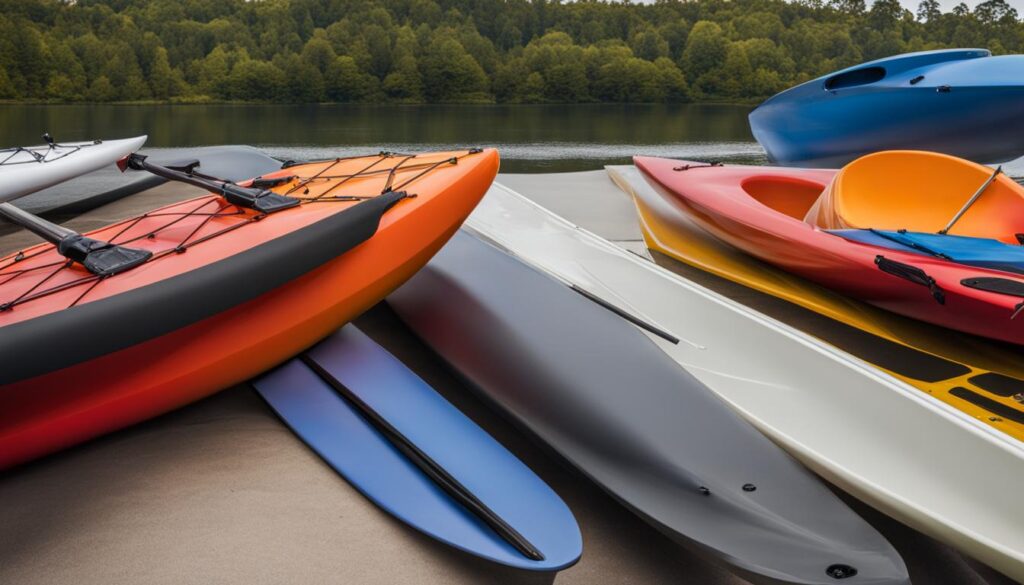When considering purchasing a kayak, it’s important to understand the weight of different types of kayaks. The weight of a kayak can affect usability, including how often you use it and how tired you become when handling it. Factors such as materials used, size, and purpose can all contribute to the weight of a kayak. The weight of a kayak is an important consideration in order to ensure that it is manageable and suited to your needs.
Whether you’re an experienced kayaker or a beginner, understanding the weight of a kayak is crucial. A lighter kayak can offer easier maneuverability and transportability, while a heavier kayak may provide more stability or have a higher weight capacity. By comparing different types of kayaks and their respective weights, you can make an informed decision and find the optimal choice for your kayaking adventures.
Key Takeaways:
- Understanding the weight of a kayak is important for usability and enjoyment.
- Factors such as materials, size, and purpose contribute to the weight of a kayak.
- Lighter kayaks offer easier maneuverability and transportability.
- Heavier kayaks may provide more stability or have a higher weight capacity.
- Consider your own capabilities and preferences when choosing a kayak with an optimal weight.
Does Kayak Weight Matter?
When it comes to kayaking, the weight of your kayak does matter. It can have a significant impact on your overall experience and the usability of the kayak. A kayak that is too heavy can make it difficult for you to maneuver and handle, leading to fatigue before you even hit the water. On the other hand, a kayak that is too light may lack stability and may not be able to hold your weight comfortably. Therefore, finding the right balance in kayak weight is essential for an optimal kayaking experience.
The weight of a kayak can directly affect its performance. A lighter kayak tends to be more agile and easier to paddle, allowing you to navigate through different water conditions with ease. It also requires less effort to transport and launch, making it more convenient for solo trips. On the other hand, a heavier kayak may provide better stability and buoyancy, making it suitable for rougher waters or when carrying additional gear.
Another aspect to consider is the impact of kayak weight on storage and transportation. If you have limited storage space or need to transport your kayak frequently, a lighter kayak can be more manageable and easier to handle. It can also make a difference if you need to lift your kayak onto a roof rack or carry it for longer distances. However, keep in mind that lighter kayaks may be more susceptible to damage from impacts or rough handling.
The Importance of Balancing Kayak Weight
While kayak weight does matter, it’s also essential to consider other factors when choosing a kayak. Weight alone should not be the sole determining factor. Instead, you should strive to find a balance between weight, stability, maneuverability, and other features that are important to you. Think about your own abilities, preferences, and the specific type of kayaking you plan to do.
- Consider the type of kayaking you will be doing most frequently. Are you planning to use your kayak for leisurely paddling, fishing, or exploring challenging waters?
- Think about your own physical capabilities and strength. Can you comfortably handle a heavier kayak, or would a lighter option be more suitable for you?
- Take into account the specific conditions and environments where you will be kayaking. Different types of water and weather conditions may require different kayak weights for optimal performance and safety.
- Evaluate the storage and transportation options you have available. Will a heavier kayak be too burdensome to handle, or can you easily accommodate its weight?
By considering these factors along with the weight of the kayak, you can make a more informed decision that aligns with your needs and preferences. Remember, the right kayak weight for you will ultimately depend on your unique circumstances as a kayaker.
Types of Kayaks
When it comes to choosing a kayak, there are various types available to cater to different preferences and activities. Understanding the different types of kayaks can help you make an informed decision based on your needs and preferences. Here are some of the most common types of kayaks:
1. Single Recreational Kayaks
Single recreational kayaks are designed for individual paddlers and offer versatility and maneuverability on calm water. These kayaks are typically lightweight, ranging from 15 to 30 kilograms, making them easy to handle and transport. They are suitable for beginners and casual paddlers looking for a fun and leisurely experience on the water.
2. Tandem Kayaks
Tandem kayaks are designed for two paddlers, making them a great option for couples, friends, or families who want to paddle together. These kayaks are larger and can accommodate more weight, ranging from 25 to 45 kilograms. They offer stability and allow for teamwork and coordination between paddlers.
3. Fishing Kayaks
Fishing kayaks are specifically designed for anglers and offer additional features and accessories to enhance the fishing experience. These kayaks are generally heavier due to the added storage compartments and equipment, weighing between 16 and 55 kilograms. They provide stability and functionality for fishing enthusiasts who want to explore different fishing spots.
4. Inflatable Kayaks
Inflatable kayaks are known for their portability and ease of storage. These kayaks can be deflated and packed into a compact size, making them convenient for travel and transportation. The weight of inflatable kayaks can vary depending on the materials used and manufacturing techniques, ranging from under 9 kilograms to over 25 kilograms. They offer versatility and are suitable for various water conditions.
By understanding the different types of kayaks and their respective weights, you can choose the one that best suits your needs and preferences. Whether you’re looking for a solo adventure, a paddling experience with a companion, or a fishing expedition, there is a kayak out there for you.
How Material Affects Kayak Weight
When choosing a kayak, it’s important to consider the construction material as it directly affects the weight of the kayak. Different kayak materials have their own unique characteristics, which can impact not only the weight but also the performance and durability of the kayak.
One common kayak construction material is rotomolded plastic, which is made by melting plastic pellets and molding them into shape. Rotomolded kayaks tend to be the heaviest option available. They are also often the most affordable, making them a popular choice for beginners or those on a budget.
Thermoform kayaks are made by layering sheets of plastic over a mold and then heating and vacuum-forming them into shape. This construction method offers a lighter weight compared to rotomolded kayaks while still being relatively affordable. Thermoform kayaks provide a good balance between weight and cost.
Fiberglass or composite kayaks are known for their lightweight and high-performance characteristics. These kayaks are made by layering fiberglass or carbon fiber sheets over a mold and then applying resin to create a strong and lightweight structure. Fiberglass kayaks are ideal for those looking for speed and agility on the water, but they can be more expensive than plastic kayaks.
Wood kayaks
Another option is wood kayaks, which are typically constructed using different types of wood and fiberglass resin for waterproofing. The weight of wood kayaks can vary depending on the type of wood used and the thickness of the fiberglass coating. Wood kayaks offer a unique aesthetic appeal and can provide a smooth and quiet paddling experience.
It’s important to consider the construction material when choosing a kayak that best suits your needs. Each material offers its own advantages and disadvantages in terms of weight, performance, and cost. By understanding the impact of material on kayak weight, you can make an informed decision and find the kayak that will enhance your paddling experience.
Weight of Single Kayaks
When it comes to single kayaks, their weight can vary depending on various factors such as size, materials used, and included accessories. Single kayaks typically weigh between 15 and 30 kilograms, providing a manageable option for individual paddlers. Here are some examples of single kayak weights:
- The Expedition 2 kayak weighs 28 kilograms and has a weight limit of 155 kilograms, making it suitable for longer adventures.
- The Quest 309 kayak weighs 18 kilograms, offering a lightweight option for easier transportation and maneuverability.
These examples demonstrate the range of weights you can expect to find when considering a single kayak. It’s important to consider not only the weight but also the weight capacity of the kayak to ensure it can accommodate your needs.
Keep in mind that the weight of a single kayak can impact its portability, ease of transportation, and overall performance in the water. Finding the right balance between weight and other important factors such as stability and storage space is key to choosing the optimal single kayak for your kayaking adventures.
Summarize:
– Single kayaks typically weigh between 15 and 30 kilograms.
– The Expedition 2 kayak weighs 28 kilograms with a weight limit of 155 kilograms.
– The Quest 309 kayak weighs 18 kilograms and offers a lightweight option.
– Consider both weight and weight capacity when choosing a single kayak.
– Balance weight with other factors such as stability and storage space.
Weight of Tandem Kayaks
Tandem kayaks are designed for two paddlers and tend to weigh more than single kayaks due to their larger size. The weight of tandem kayaks typically ranges from 25 to 45 kilograms, making them manageable for two people to carry and paddle. Finding the right weight for a tandem kayak depends on factors such as the materials used, construction design, and included features.
For example, the Sun Dolphin Bali Tandem Kayak weighs approximately 31 kilograms, providing a stable and comfortable experience for two paddlers. Another option is the Perception Rambler 13.5T Tandem Kayak, which weighs around 40 kilograms and offers ample space and stability for two individuals.
Summary:
- Tandem kayaks are designed for two paddlers and tend to weigh more than single kayaks.
- The weight range for tandem kayaks is typically between 25 and 45 kilograms.
- Examples of tandem kayak weights include the Sun Dolphin Bali Tandem Kayak at approximately 31 kilograms and the Perception Rambler 13.5T Tandem Kayak at around 40 kilograms.
When selecting a tandem kayak, it’s important to consider the weight in relation to your intended use and physical capabilities. Lighter tandem kayaks may be easier to transport and maneuver, while heavier ones may provide added stability and durability for longer trips or rougher waters. Ultimately, finding the right balance between weight, features, and overall performance will ensure an enjoyable experience for both paddlers.
Weight of Fishing Kayaks
When it comes to fishing kayaks, weight is an important factor to consider. The weight of a fishing kayak can vary depending on the specific model and features it offers. Whether you plan on paddling to your favorite fishing spot or transporting your kayak to different locations, the weight of the kayak will play a role in its portability and ease of use.
Here are some examples of fishing kayak weights to give you an idea of the range:
- The Bighead Angler weighs just 19 kilograms, making it a lightweight option for those who prioritize mobility. Despite its low weight, it still offers generous storage compartments for your fishing gear.
- On the other end of the spectrum, the Angler Pro XL weighs 34 kilograms due to its additional features and accessories. This kayak provides ample space and stability for serious anglers.
When deciding on the weight range for your fishing kayak, consider how you plan to use it and what your specific needs are. If you prefer a more nimble and easily transportable kayak, opting for a lighter weight model may be ideal. However, if you need extra storage space and stability for longer fishing trips, a slightly heavier kayak might be a better choice.
Factors to Consider When Choosing a Fishing Kayak
In addition to weight, there are other factors to consider when choosing a fishing kayak. Here are a few key considerations:
- Stability: Fishing kayaks need to be stable to provide a reliable platform for casting and reeling in fish. Look for kayaks with a wider beam or hull design that enhances stability.
- Storage: Consider how much gear and equipment you’ll be bringing on your fishing trips. Look for kayaks with ample storage options, such as compartments or bungee cords, to secure your fishing gear.
- Comfort: Spending hours on the water can be tiring, so ensure your fishing kayak offers comfortable seating and adjustable features to accommodate your preferences.
By considering these factors along with the weight of the fishing kayak, you can find the perfect balance that meets your needs and enhances your fishing experience.
Weight of Inflatable Kayaks
If you’re looking for a lightweight and portable option for kayaking, inflatable kayaks are a great choice. They offer the convenience of easy storage and transportation, while still providing a reliable and fun paddling experience. The weight of inflatable kayaks can vary depending on the specific model and materials used.
Weight Range for Inflatable Kayaks
The weight of inflatable kayaks typically ranges from under 9 kilograms to over 25 kilograms. This range allows for different options based on your preferences and needs. Lighter inflatable kayaks are easier to carry and maneuver, making them ideal for solo adventurers or those with limited strength. On the other hand, heavier inflatable kayaks provide added stability and durability, making them suitable for longer trips or rougher waters.
Examples of Inflatable Kayak Weights
For instance, the Bay Sports Air Glide Hybrid weighs 11 kilograms, making it one of the lighter options available. Despite its lightweight design, it offers the feel and performance of a traditional hard-shell kayak. On the other hand, the Sea Eagle 370 inflatable kayak weighs 22 kilograms, providing a balance between portability and stability. It can accommodate up to three people and is perfect for recreational use and family outings.
When choosing an inflatable kayak based on weight, consider the intended use, the number of paddlers, and the level of comfort and stability required. It’s also important to check the weight capacity of the kayak to ensure it can support both you and your gear. Overall, inflatable kayaks offer a versatile and convenient option for kayakers of all skill levels.
How Much Does a Canoe Weigh?
When comparing canoes and kayaks, one common consideration is their weight. While canoes are often perceived as heavier due to their bulkier size, the weight difference between canoes and kayaks is not always significant. On average, canoes weigh between 230 and 260 pounds, depending on the specific model and materials used. The open deck design of canoes can help reduce weight compared to the enclosed cockpit design of kayaks.
If weight is a key factor in your decision-making process, it’s important to note that there are kayaks available that can be comparable in weight to canoes. Some tandem kayaks, designed for two paddlers, can weigh in the same range as canoes. Additionally, advancements in kayak construction and materials have allowed for the development of lightweight kayaks that offer a similar paddling experience to traditional canoes.
When comparing the weight of canoes and kayaks, it’s essential to consider other factors as well. Kayaks generally offer better maneuverability and agility on the water, while canoes provide more open space and allow for easier access to gear. The choice between a canoe and a kayak ultimately depends on your personal preferences and the specific activities you plan to engage in.
Weight Comparison of Canoes and Kayaks:
- Canoe: 230-260 pounds (average)
- Tandem Kayak: Similar weight range as canoes
- Traditional Kayak: Varies based on design and materials used
Before making a decision, it’s recommended to visit a local retailer or rental facility to test out both canoes and kayaks. By trying each type of watercraft, you can assess their weight, comfort, and overall suitability for your needs. This hands-on approach ensures that you make an informed choice, selecting the watercraft that aligns with your paddling goals and preferences.
Conclusion
The weight of a kayak is an important factor to consider when choosing the right one for your needs. By understanding the impact of kayak weight on usability, you can ensure a more enjoyable kayaking experience. However, weight alone should not be the sole determinant in your decision-making process.
When choosing a kayak, it is crucial to balance weight with other factors such as buoyancy, stability, and storage space. Consider your own capabilities and preferences to find a kayak that is both manageable and suited to your needs. The construction material, kayak type, and dimensions also play significant roles in determining the weight of a kayak.
Ultimately, the goal is to find the perfect balance between weight and other important factors. By doing so, you can have a lightweight kayak that is easy to handle without sacrificing performance or functionality. So, before your next kayaking adventure, take the time to carefully consider all the factors involved in choosing the right kayak for you.










